Introduction
Understanding the nuances of autism spectrum disorder (ASD) and ensuring timely intervention is essential for a child's development. An Autism Risk Calculator serves as a crucial tool in this journey, offering parents a way to assess the likelihood of their child being on the autism spectrum by considering factors such as family history, developmental milestones, and behavioral observations. Early identification through such tools can significantly impact a child's life by enabling timely evaluations and interventions during critical neurodevelopmental periods.
This article delves into how Autism Risk Calculators work, the key components involved, and the various factors considered in risk assessment. It also explores the interpretation of results, the limitations of these tools, and the overarching importance of professional evaluations. Ultimately, the goal is to empower parents with the knowledge and resources needed to support their child's developmental trajectory and ensure the best possible outcomes.
What is an Autism Risk Calculator?
An Autism Risk Calculator is a vital tool that helps in assessing the likelihood of an individual being on the autism spectrum by evaluating various risk factors, including family history, developmental milestones, and behavioral observations. Timely recognition is vital as postponements in diagnosis can lead to lost chances for prompt support during essential neurodevelopmental phases, where assistance can greatly influence a young person's life. According to a study by Scott Badesch, former President of the Autism Society of America, long wait times for evaluations and the absence of a standard care protocol are major concerns, with two-thirds of specialty care centers reporting wait times exceeding four months. This tool offers parents important perspectives, allowing them to pursue prompt assessments and support, thereby encouraging improved long-term results for their offspring. Evidence also shows that early childhood interventions, such as naturalistic developmental behavioral interventions, improve core challenges associated with the condition, particularly difficulties with social communication. By utilizing an Autism Risk Calculator, parents can gain a clearer insight into their offspring's developmental path and make educated choices concerning support and resources, ultimately improving their development and quality of life.
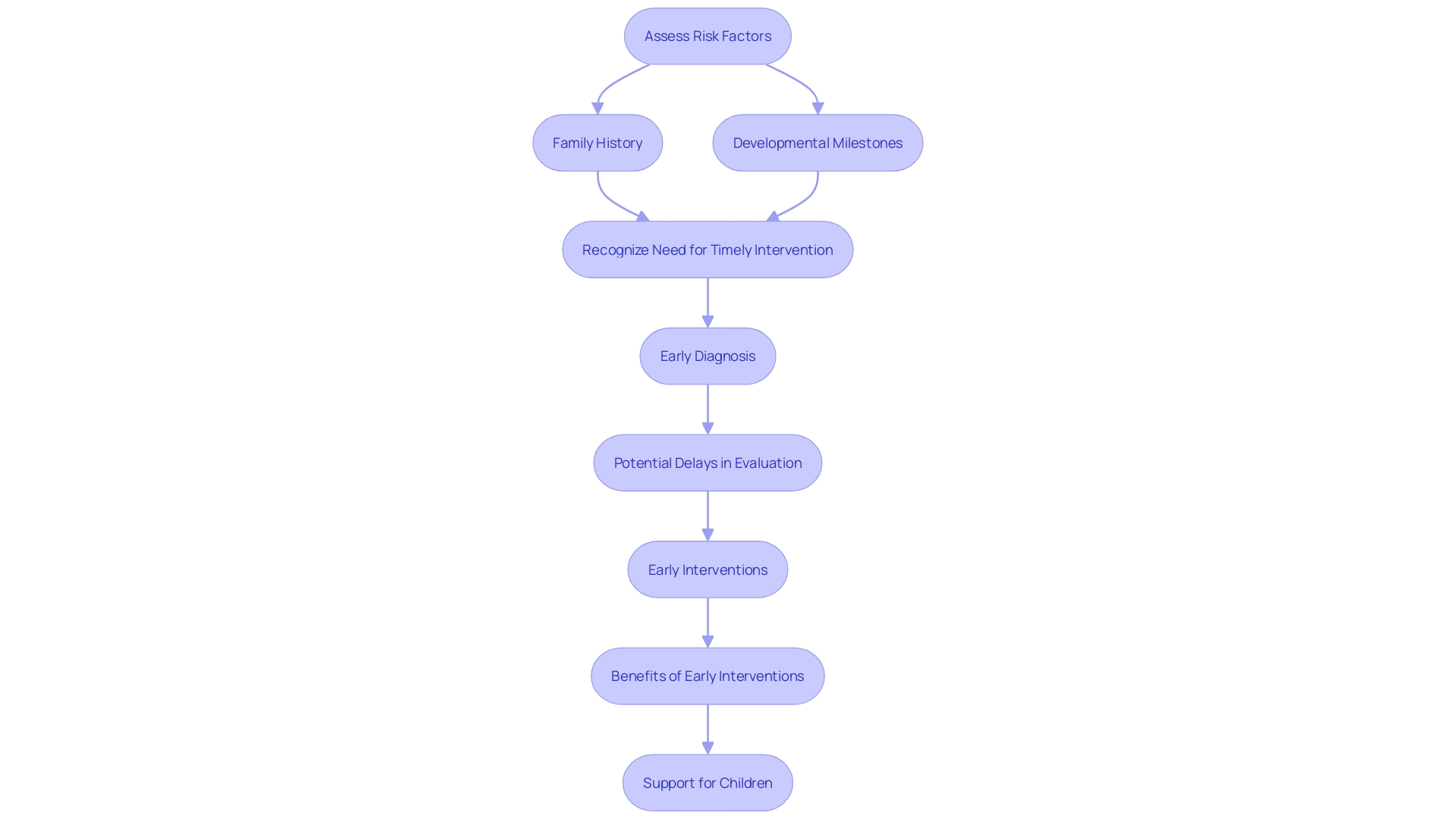
How Does an Autism Risk Calculator Work?
The Autism Risk Calculator leverages sophisticated algorithms to analyze data derived from standardized questionnaires and assessments. By collecting feedback from parents regarding their offspring’s developmental achievements, behaviors, and family background, this tool produces a thorough risk assessment for the condition. Notably, a significant portion of screening tests related to developmental disorders—63.1% according to recent studies—are completed by parents, underscoring their crucial role in recognizing early signs due to their intimate understanding of their offspring's emotions and behaviors. This parental input is crucial as it contributes to the calculation process, offering a comprehensive perspective on potential risk factors.
The accuracy and efficacy of such tools are continually improving. For example, researchers at Karolinska Institutet have created a model, AutMedAI, which forecasts developmental disorders in youngsters under two with nearly 80% accuracy by analyzing 28 simple parameters, including the age of the first smile and the presence of eating difficulties. This breakthrough emphasizes the potential of early intervention, which can significantly improve results for young individuals and their families.
Moreover, advancements in technology, such as the eye-tracking diagnostic tool created by researchers in Atlanta, are transforming the field of neurodevelopmental disorder diagnosis. This tool, which monitors children's looking behaviors while they watch videos of social interactions, provides clinicians with detailed insights into the young person's social, verbal, and non-verbal abilities. These innovations exemplify the ongoing efforts to refine autism risk calculators and diagnostic tools, making them more accessible and effective for parents and healthcare professionals alike.
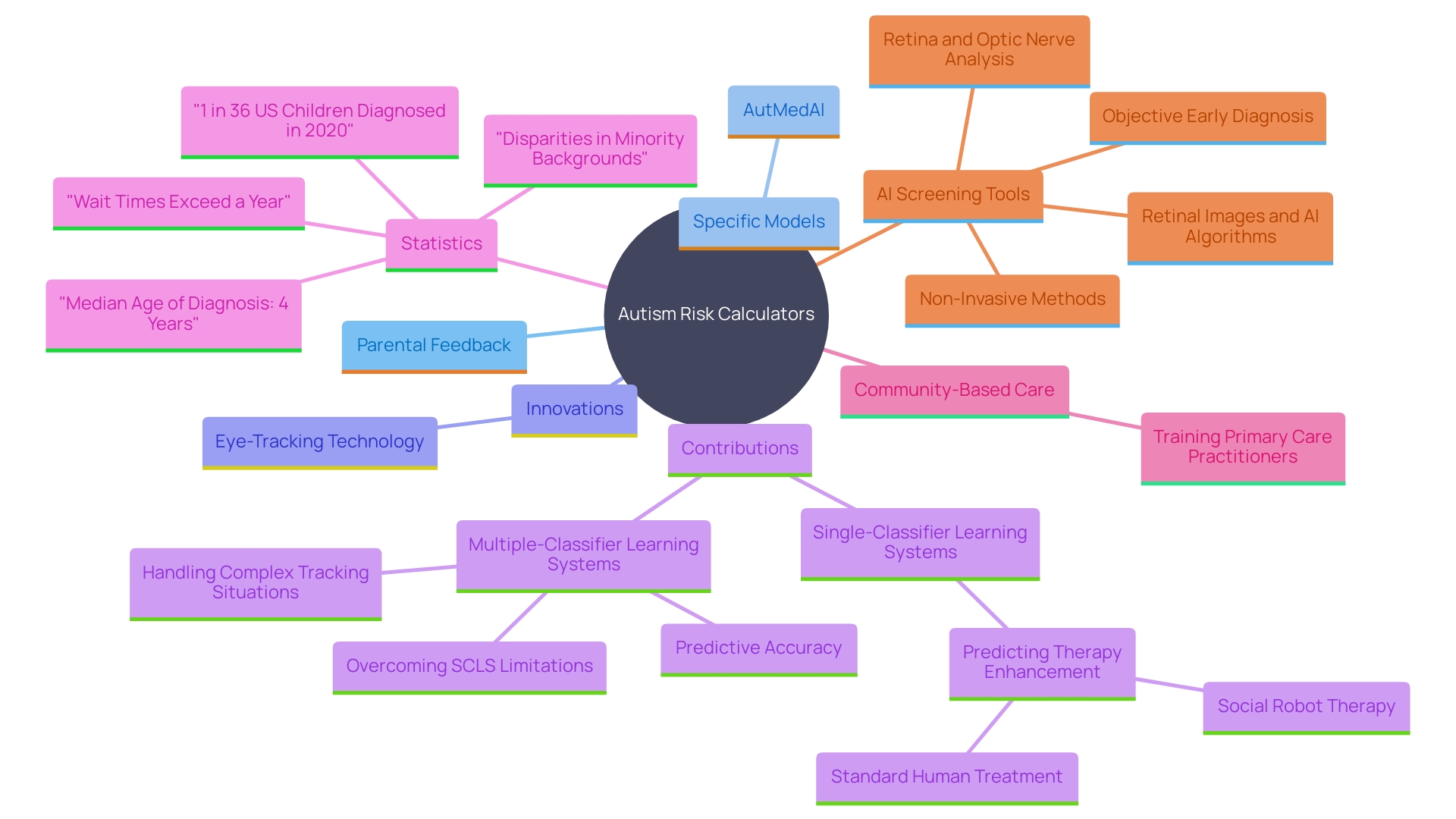
Key Components of Autism Risk Calculators
An Autism Risk Calculator integrates several key components to provide a comprehensive risk evaluation for young individuals. These components include user input fields for developmental history, behavioral observations, and demographic information. By capturing detailed descriptions from parents or caregivers about their offspring's development and combining this with professional observations of the individual's behavior, the calculator aligns with the diagnostic approach outlined in the DSM-5. This standardized method ensures that the tool is both reliable and thorough.
Moreover, the Autism Risk Calculator can guide parents in understanding their child's unique developmental trajectory. 'Timely identification and action are essential, as research shows that developmental support can significantly enhance social communication and other fundamental challenges linked to autism.'. For example, early intensive behavioral intervention, which incorporates operant conditioning and targets functional skills, is often recommended in the United States.
The calculator's customized risk evaluation can also assist in making informed choices regarding additional assessments or recommendations to experts, such as neurodevelopmental pediatricians or neurologists specializing in children. This tailored approach ensures that each individual's specific needs are addressed, promoting better long-term outcomes and supporting the well-being of both the individual and their family.
Factors Considered in Autism Risk Calculation
Autism risk calculators consider various factors, each influencing an individual's overall risk profile. Genetic predispositions play a significant role, especially with findings such as the increased risk of developmental disorders among children born to older fathers, potentially linked to genetic mutations like those in the BEGAIN gene. Additionally, neighborhood disadvantage has been linked to a greater likelihood of developmental disorder diagnoses, indicating that socio-economic factors can't be overlooked.
Environmental influences also factor in, with studies showing that maternal autistic traits, even without a formal diagnosis, can be associated with adverse birth outcomes, including preterm birth and low birth weight. This highlights the importance of tailored antenatal care for mothers with high autistic traits.
'Developmental milestones are another crucial element, and tools like AI-assisted retinal scans are emerging as innovative methods to evaluate the risk of developmental disorders.'. For example, Korean researchers have shown that images of young ones' retinas can be utilized to assess for this condition, providing a non-invasive method to evaluate the probability and potentially the intensity of the disorder.
By combining these components, risk assessment tools offer guardians a thorough insight into their offspring's risk, allowing them to pursue timely intervention and suitable assistance customized to their unique requirements.
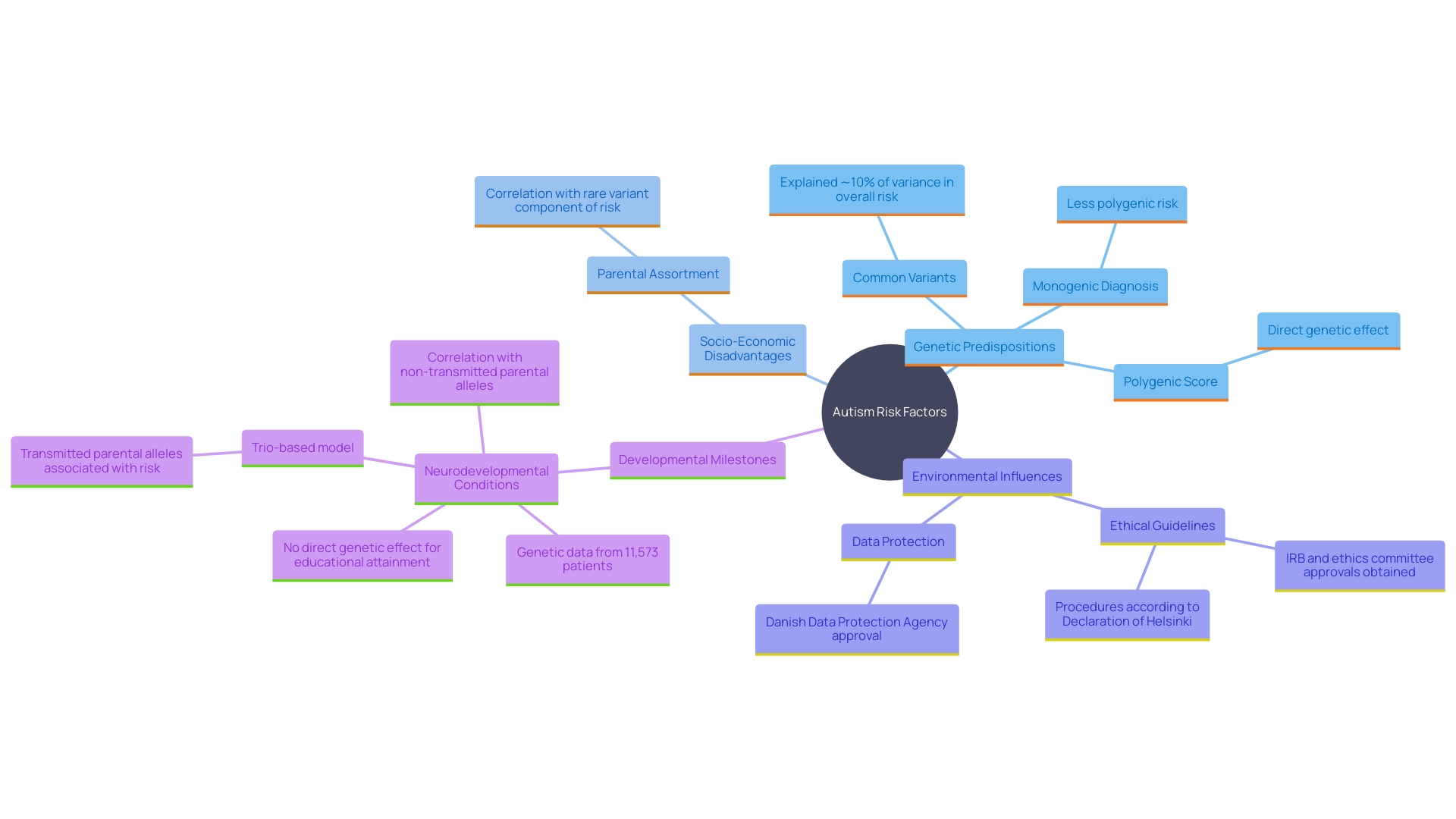
Understanding Risk Categories
Risk categories in assessments for developmental disorders typically range from low to high risk, offering a clearer picture of a child's developmental trajectory. Early identification through regular health visits and developmental screenings at 18 and 24 months, as recommended by the National Institute of Child Health and Human Development (NICHD), is crucial. These assessments often involve evaluating communication, social behavior, and other behavioral patterns, which can highlight potential concerns in a timely manner.
For instance, the Centers for Disease Control and Prevention (CDC) has outlined specific signs and symptoms to watch for, which can guide further evaluation. Evidence indicates that early actions, such as naturalistic developmental behavioral strategies, significantly enhance fundamental challenges related to developmental disorders, especially in social communication. By understanding these risk categories, parents can make informed decisions about seeking further professional evaluation and intervention, ultimately supporting their offspring's development more effectively.
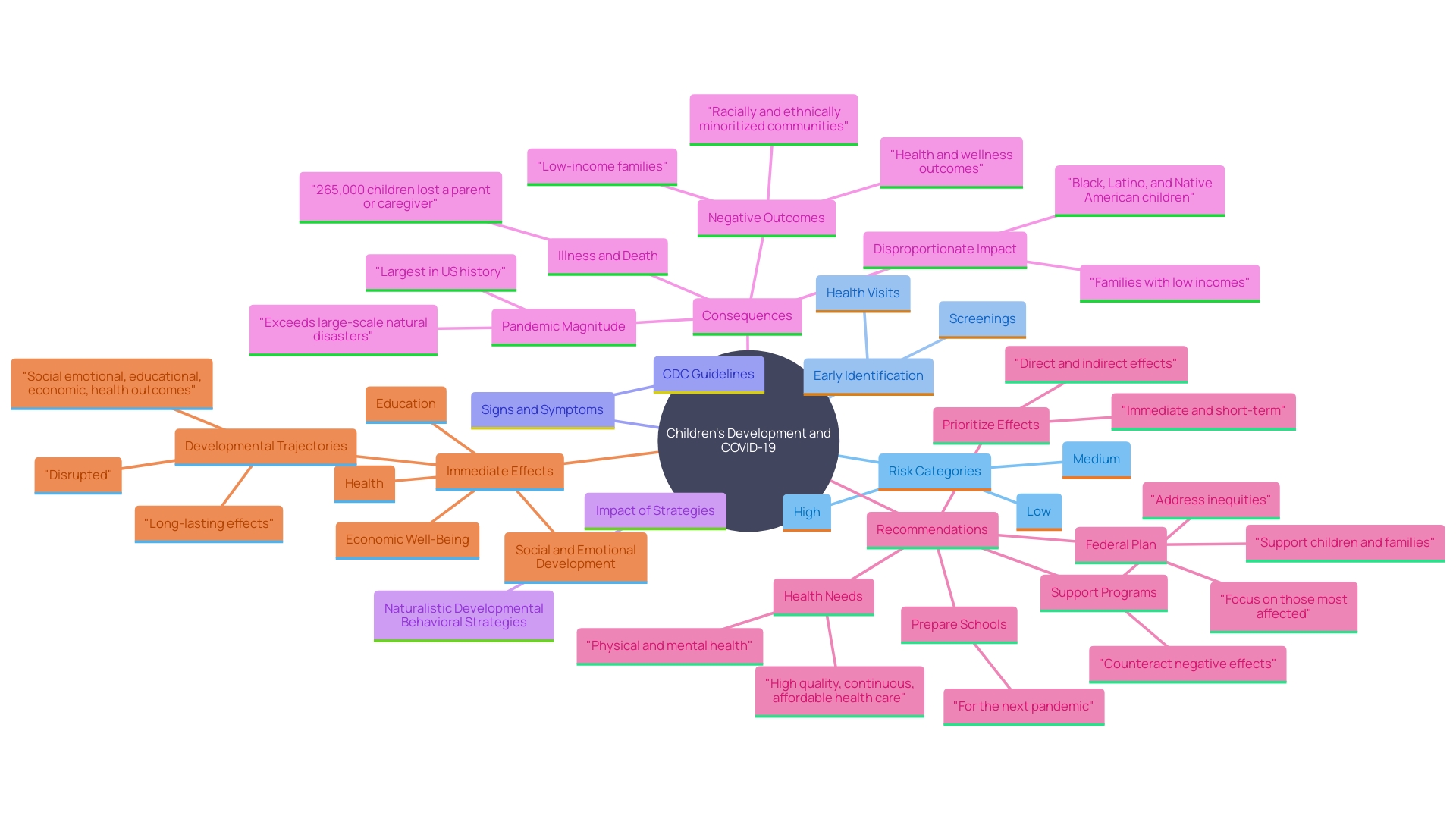
Interpreting Autism Risk Calculator Results
Interpreting results from an Autism Risk Calculator calls for thoughtful analysis. A higher risk score does not automatically indicate a young person has a developmental disorder, just as a lower score does not ensure they are not on the spectrum. These results should be viewed as a preliminary step for deeper discussions with healthcare professionals. Based on a cohort study involving 1.3 million young individuals in Ontario, Canada, the rate of the developmental disorder was observed to be greater in offspring of individuals experiencing infertility, especially after fertility therapy. This highlights the complexity of risk factors and the necessity for comprehensive evaluation.
The Autism Risk Calculator evaluates various parameters such as family history, developmental milestones, and behavioral observations. Associate Professor Kristiina Tammimies from Karolinska Institutet highlights that tools like these, demonstrating up to 80% accuracy for children under two, can greatly assist in timely support, which is vital for enhancing long-term results. Early diagnosis and intervention have been shown to enhance social communication and alleviate core challenges associated with autism.
It's important to remember that these tools provide an initial assessment. As Tony Pistilli, FSA, MAAA, cera Consulting Actuary, suggests, a total risk analysis approach is essential for making informed decisions. Likewise, the Autism Community in Action (TACA) stresses the importance of early and accurate diagnostic tools to bridge the critical gap in existing technologies, ensuring that families receive timely support. Always consult healthcare providers to interpret these results and plan the next steps for your offspring's development.
Limitations and Importance of Professional Evaluation
While Autism Risk Calculators can provide valuable insights, they are not definitive tools. Professional evaluations by qualified practitioners remain crucial for an accurate diagnosis. These evaluations consider a broader range of factors and provide a comprehensive understanding of a young person's needs. According to the American Psychiatric Association's Diagnostic and Statistical Manual, Fifth Edition (DSM-5), diagnosing a spectrum disorder relies heavily on two main sources: parents' or caregivers' descriptions of their offspring's development and a professional's observation of the young person's behavior. It's important to note that no single tool should be used as the sole basis for diagnosis, emphasizing the need for thorough, multifaceted assessments.
In the United States, the median age for diagnosis of the condition is after 4 years, with significant disparities for young individuals from racial and ethnic minority backgrounds and underserved regions. 'Wait periods for diagnostic assessments frequently surpass a year, partly due to the high number of young children needing an evaluation for developmental disorders that greatly outweighs the available specialists.'. This postponement in diagnosis can hinder participation in intensive evidence-based approaches, which aid development during the crucial phase of neuroplasticity.
Experts like Scott Badesch, former President of the Autism Society of America, highlight major concerns within the healthcare community, such as excessively long waitlists and the absence of a standard of care, which disproportionately affect disadvantaged families. Studies also endorse the advantages of childhood programs, especially for enhancing social communication and tackling fundamental issues linked to autism. Nonetheless, these advantages are most effectively achieved when diagnosis and action take place promptly, emphasizing the significance of timely and thorough professional assessments.
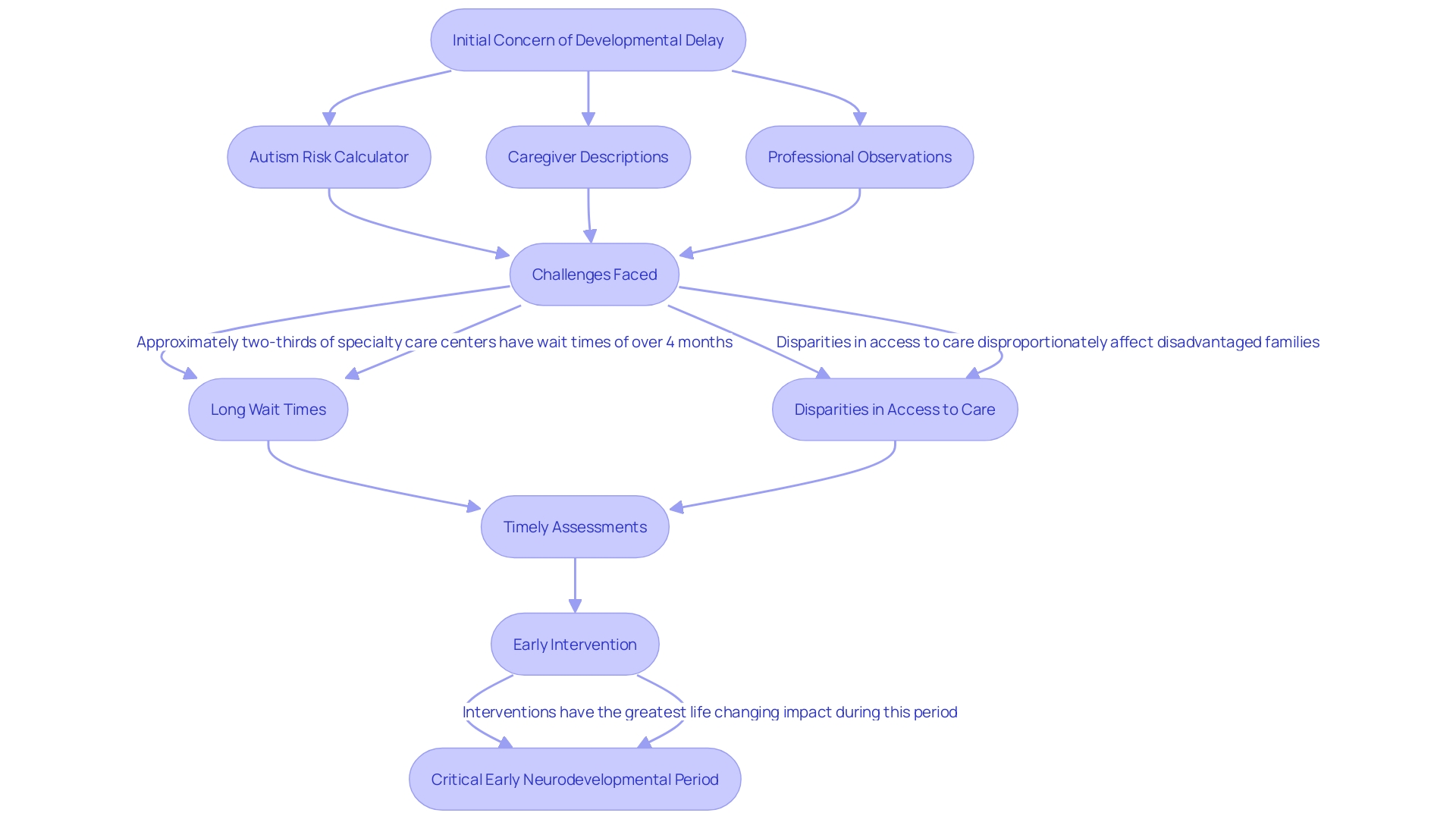
Benefits of Using an Autism Risk Calculator
Utilizing an Autism Risk Calculator can greatly assist parents by providing initial insights into their offspring’s developmental trajectory. Prompt identification of possible hazards can enable timely and focused actions, improving the child's overall growth and quality of life. Based on a study, initial childhood programs, such as behavioral and developmental therapies, have demonstrated significant advantages in enhancing social communication and adaptive behaviors.
One notable example is the use of naturalistic developmental behavioral approaches, which have demonstrated significant improvements in social communication and play behaviors. These measures are especially beneficial when implemented during the crucial initial years, a time when the brain's neuroplasticity is at its highest. Studies show that 90% of brain growth takes place before the age of five, highlighting the significance of timely support.
Additionally, pediatricians play an essential role in guiding families toward suitable initial childhood support. However, the landscape of available options varies widely, and best practice guidelines differ across countries. 'For example, in the United States, intensive behavioral support is frequently suggested, whereas in England, less intense methods like pediatric communication therapy for developmental disorders are supported.'.
'The importance of early action is further emphasized by the fact that delays in diagnosis can lead to missed chances for essential early assistance.'. A report by the Autism Society of America emphasizes the long wait times for autism evaluations, with many families waiting over four months from the initial request to the diagnostic evaluation.
Therefore, utilizing an Autism Risk Calculator can equip parents with valuable information, enabling them to seek timely evaluations and interventions that can profoundly impact their child’s developmental trajectory and well-being.
Conclusion
Understanding the complexities of autism spectrum disorder (ASD) is essential for parents navigating their child's developmental journey. Autism Risk Calculators serve as a vital resource, enabling parents to assess their child's likelihood of being on the spectrum through a comprehensive evaluation of various factors such as family history, developmental milestones, and behavioral observations. Early identification is key, as it opens the door to timely interventions that can significantly enhance a child's quality of life.
The functionality of Autism Risk Calculators lies in their ability to analyze data collected from standardized questionnaires and input from parents. This collaborative approach ensures that the insights provided are accurate and reflective of the child's unique developmental trajectory. While these tools offer valuable preliminary assessments, it is crucial to interpret results carefully and in conjunction with professional evaluations.
The potential for early intervention cannot be overstated, as research shows that timely support can lead to substantial improvements in social communication and adaptive behaviors.
Despite the advantages of using Autism Risk Calculators, it is important to recognize their limitations. They should not replace professional assessments, which consider a broader range of factors and provide a comprehensive understanding of a child's needs. The role of qualified practitioners remains indispensable in ensuring accurate diagnoses and effective intervention strategies.
By leveraging the insights gained from these calculators alongside professional guidance, parents can take proactive steps to support their child's development and well-being, ultimately fostering a more promising future.




